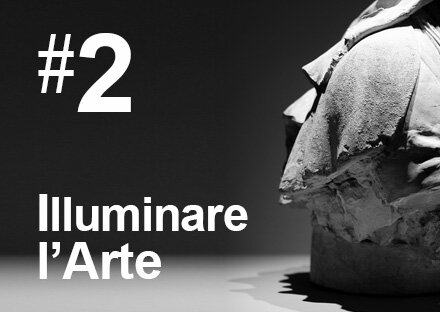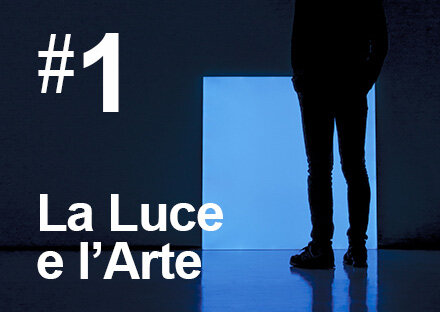Art in light, light in art. Painting as inspiration, constant reference.
Theatrical light, born of the idea of putting things centre stage.
Tailored light, custom-made suit for the work of art.
Lighting as synthesis and subtraction.
A path, a narration through light that goes back to the etymology of the word “photography” - writing with light - to deepen and understand the importance of the relationship between Davide Groppi Light and Art.
PATH #1 | DAVIDE GROPPI LIGHT AND ART
PATH #3 | LIGHT IN ART
LIGHT IN THE WORKS OF THE PEGGY GUGGENHEIM COLLECTION IN VENICE
Three podcasts created by The Peggy Guggenheim Collection in collaboration with Davide Groppi addressing the topic of light in art
The profound and constant connection between the light of Davide Groppi and modern and contemporary art have found a synthesis.
This achievement culminated in 2018 when the company joined Guggenheim Intrapresæ, the prestigious group of cutting-edge companies that supports the programming and activities of the Peggy Guggenheim Collection in Venice.
This extraordinary collection, which is viewed by more than 380000 people every year, includes masterpieces by Picasso, Dalí, Magritte, Brâncuși, Pollock, Ernst and - to cite only a few of the Italian artists in the Collection - Fontana, Vedova, de Chirico, Boccioni, Severini, Basaldella, Accardi.
The connection developed in 2019 with the event NelBlu, a sensorial journey between light and art created at the PGC by Davide Groppi and inspired in particular by "The Empire of Light", an extraordinary work by René Magritte, which is part of the museum’s permanent collection. This work by Magritte represents, in a plastic and definitive manner, the importance of light in art and its centrality in creating evocative atmospheres, changing the reality, and bringing the spectator to "another" dimension.
Davide Groppi and The Peggy Guggenheim Collection: a collaboration revolving around light
Today, the collaboration with the Peggy Guggenheim Collection focuses on a topic that is particularly important for us: the use of light by artists when they create their work.
The three selected works may not be famous, but well represent the topic of the “artist’s light”. To do so, the PGC prepared three original podcasts, one for each work of art, which discuss the topic in an in-depth manner. The selected works of art are: Windows Open Simultaneously 1st Part 3rd Motif (1912) by Robert Delaunay, Untitled (1953) by Tancredi Parmeggiani, and Twenty-three glass sculptures after sketches by Picasso (1964) by Egidio Costantini.
Windows Open Simultaneously 1st Part 3rd Motif (1912) by Robert Delaunay
This work is one of the "fragments of a rainbow" created by Robert Delaunay in his Windows series.
It expresses the scientific knowledge at the beginning of the Twentieth century about light and colour, an integral part of the author’s artistic journey.
Windows Open Simultaneously 1st Part 3rd Motif addresses the reflection on light which is at the centre of the artist’s work.
The light fragments reality and creates an iridescent rhythm that forces the eye to move constantly across the canvas, searching for an impossible point of reference.
"Light is here revealed in all its truth," wrote Apollinaire inspired by Delaunay’s work.
Untitled (1953) by Tancredi Parmeggiani
Tancredi Parmeggiani was a precocious and innovative artist. Inspired by the iridescent and hazy light of Venetian winters, Byzantine mosaic, and the use of colour by Kandinsky, Tancredi developed an iridescent "spatial pointillism", which he used to create solid structures pervaded by soft light that almost vaporised in the atmosphere.
His career ended all too soon, when he committed suicide in 1964, but Tancredi was destined to remain unique due to his personal interpretation - typically Venetian - of the most innovative styles at his time.
Twenty-three glass sculptures after sketches by Picasso (1964) by Egidio Costantini
The transparency of glass makes it welcoming to light, ready to receive it, be shaped by it. The arts of the city of Venice, made of light, air, vibrations of water and sky, seem reflected in glass.
Egidio Costantini, a "master of glassmakers", challenged himself with the modernity of great Twentieth-century art, and had designs by Picasso, Chagall, Arp and many others made into glass, in an initiative that Cocteau called "La fucina degli Angeli [The Forge of Angels]."
The twenty-three works in glass were inspired by drawings by Pablo Picasso given to Costantini by the Spanish artist.
Available on:
Copywriter Michele Mingrone









